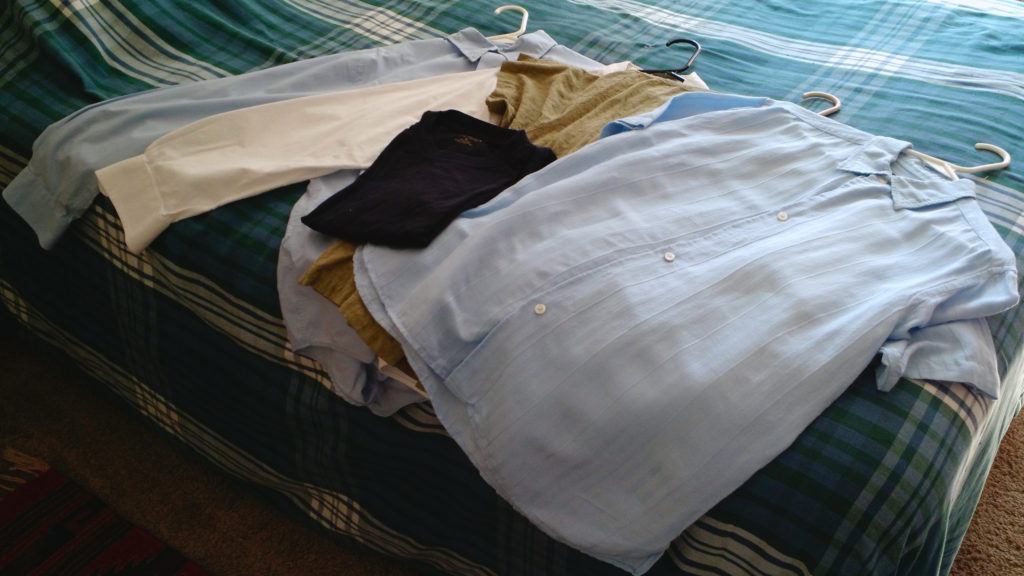One of the great luxuries of losing weight is that you can buy clothes that fit.
If you’re fat, you don’t get to buy clothes that fit. All you can do is buy “the right size,” defined as “the smallest size that goes all the way around you.” This will not (except by pure happenstance) be a size that fits correctly. The same size XXL t-shirt will be considered “the right size” for the bodybuilder, the basketball player, the linebacker, and the powerlifter, as well as the fat guy. At most it will fit one of those people well. Very likely, it will fit none of them well.
Still, things are better than they were.
Back in the early 1980s there were companies that simply didn’t make pants in waist sizes above 34, because they thought the sight of fat men wearing their clothes would taint their brand. Even brands that didn’t refuse to sell clothes in ordinary large sizes had very little for people fatter than that. I remember a comedy routine from about the same time with a fat comedian complaining that they quit making normal pants a couple of inches before they got to his size. Gesturing toward the plaid pants he was wearing, he said, “It’s not bad enough that I’m fat? I also have to dress like a clown?”
Twenty years ago, waist sizes in men’s pants went up in one-inch increments until you hit 34, then they went to two-inch increments. So, if the right size for you was 35, you either wore a 36 and cinched your belt to keep them up, or else you wore a 34 and got it to go around you by wearing it under your waist and letting your belly sag over the front of your pants. About fifteen years ago companies started selling pants with a 35-inch waist. Not long after they started selling pants with a 37-inch waist. The companies figured out there was a big market for big people.
During the five years or so that I’ve been losing weight, I’ve been making the smallest possible investments in my wardrobe, figuring that I’d wait until I was at a stable weight before buying more new clothes than the minimum needed to keep myself dressed until laundry day. I bought about two new t-shirts when I hit size L, and then three more when size M started fitting.
Finally, just in the last few weeks, I’ve started buying a significant amount of new clothes that actually fit.
Which brings me back to my starting point: The luxury of being able to buy clothes that fit.
Last week I went to the nearby Goodwill store and spent half an hour going through the men’s shirts. Short-sleeve men’s shirts in size M pretty routinely just fit. (The exception was a very nice Brooks Brothers shirt that was way too big. It was so nice I was sorely tempted to go through the size S men’s shirts to see if I could find something from Brooks Brothers.) Long sleeve shirts are trickier because I have short arms, but even so I found two shirts that fit—one in the exact right size, another in a size that should have had sleeves a little too long, but that must have been altered by the previous owner.
Here’s my Goodwill haul:

It would not have been so easy if I still wore XL or XXL. Except by pure luck (like the white shirt whose sleeves had been shortened to my size), nothing would have fit well. The neck would be too tight, unless the shoulders were way too big, and the sleeves would all be too long.
Clothes that fit: One more convenience for thin people.

Oh, the luxury of clothes that fit! I had breast reduction surgery several years ago and the best part was being able to buy clothes that fit. The human body comes in such a range of shapes and sizes even at a variety of healthy weights. My husband has been on a fitness quest, really a life-style change, and has lost over 30 lbs. Some days he even weighs less than me. ;( And I have had to convince him that he actually looks better in close fitting clothes, even though he would like to be a bit thinner. When we wear baggy clothes, it looks like we covering up more girth than we actually have!
Probably because I can get clothes that fit now, I’ve started noticing whether other people’s clothes fit or not—mostly people on TV. I was surprised how many men at the political conventions had suits that were too large.
If you’re a professional on-air TV personality, then your job is to basically to look good in clothes; they all dressed great. If you’re a national-level politician, you probably have enough suit-wearing occasions to make it worth getting your suits altered regularly, as you gain or lose weight. But I guess mid-level local politicians just dress themselves the way we dress schoolchildren—getting suits a little big so they’ll still fit after they grow into them.